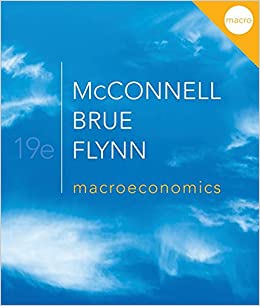
Macroeconomics 19th Edition by Campbell McConnell , Stanley Brue,Sean Flynn
Edition 19ISBN: 978-0077337728
Macroeconomics 19th Edition by Campbell McConnell , Stanley Brue,Sean Flynn
Edition 19ISBN: 978-0077337728 Exercise 3
In the accompanying tables you will find consolidated balance sheets for the commercial banking system and thE12 Federal Reserve Banks. Use columnS1 through 3 to indicate how the balance sheets would read after each of transactions a to c is completed. Do not cumulate your answers; that is, analyze each transaction separately, starting in each case from the numbers provided. All accounts are in billions of dollars.


a. A decline in the discount rate prompts commercial banks to borrow an additional $1 billion from the Federal Reserve Banks. Show the new balance-sheet numbers in column 1 of each table.
b. The Federal Reserve Banks sell $3 billion in securities to members of the public, who pay for the bonds with checks. Show the new balance-sheet numbers in column 2 of each table.
c. The Federal Reserve Banks buy $2 billion of securities from commercial banks. Show the new balance-sheet numbers in column 3 of each table.
d. Now review each of the above three transactions, asking yourself these three questions: (1) What change, if any, took place in the money supply as a direct and immediate result of each transaction? (2) What increase or decrease in the commercial banks' reserves took place in each transaction? (3) Assuming a reserve ratio of 20 percent, what change in the money-creating potential of the commercial banking system occurred as a result of each transaction?


a. A decline in the discount rate prompts commercial banks to borrow an additional $1 billion from the Federal Reserve Banks. Show the new balance-sheet numbers in column 1 of each table.
b. The Federal Reserve Banks sell $3 billion in securities to members of the public, who pay for the bonds with checks. Show the new balance-sheet numbers in column 2 of each table.
c. The Federal Reserve Banks buy $2 billion of securities from commercial banks. Show the new balance-sheet numbers in column 3 of each table.
d. Now review each of the above three transactions, asking yourself these three questions: (1) What change, if any, took place in the money supply as a direct and immediate result of each transaction? (2) What increase or decrease in the commercial banks' reserves took place in each transaction? (3) Assuming a reserve ratio of 20 percent, what change in the money-creating potential of the commercial banking system occurred as a result of each transaction?
Explanation
(a) Commercial Bank Balance Sheet (Colum...
Macroeconomics 19th Edition by Campbell McConnell , Stanley Brue,Sean Flynn
Why don’t you like this exercise?
Other Minimum 8 character and maximum 255 character
Character 255


